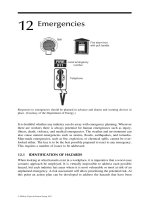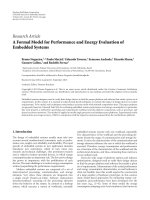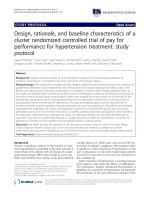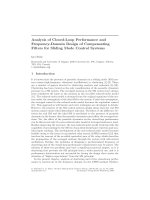Dessler ch 12 pay for performance and financial incentives
Bạn đang xem bản rút gọn của tài liệu. Xem và tải ngay bản đầy đủ của tài liệu tại đây (351.45 KB, 45 trang )
Gary Dessler
tenth edition
Part 4 Compensation
Chapter 12
Pay for Performance and
Financial Incentives
© 2005 Prentice Hall Inc.
All rights reserved.
PowerPoint Presentation by Charlie Cook
The University of West Alabama
After studying this chapter,
you should be able to:
1. Discuss the main incentives for individual
employees.
2. Discuss the pros and cons of incentives for
salespeople.
3. Name and define the most popular organizationwide variable pay plans.
4. Describe the main incentives for managers and
executives.
5. Outline the steps in developing effective incentive
plans.
© 2005 Prentice Hall Inc. All rights reserved.
12–2
12–2
Motivation, Performance, and Pay
Incentives
– Financial rewards paid to workers whose
production exceeds a predetermined standard.
Frederick Taylor
– Popularized scientific management and the use of
financial incentives in the late 1800s.
• Systematic soldiering: the tendency of employees to
work at the slowest pace possible and to produce at the
minimum acceptable level.
© 2005 Prentice Hall Inc.
All rights reserved.
12–
3
Individual Differences
Law of individual differences
– The fact that people differ in personality, abilities,
values, and needs.
– Different people react to different incentives in
different ways.
– Managers should be aware of employee needs
and fine-tune the incentives offered to meets their
needs.
– Money is not the only motivator.
© 2005 Prentice Hall Inc.
All rights reserved.
12–4
Employee Preferences for Noncash Incentives
*The survey polled a random nationwide sample of 1,004 American adults. Among those polled, 851 were working or retired
Americans, whose responses represent the percentage cited in this release. The survey was conducted June 4–7, 1999, by
Wirthlin Worldwide. The margin of error is ±3.1%. Responses total less than 100 because 4% responded “something else”.
© 2005 Prentice Hall Inc.
All rights reserved.
Source: Darryl Hutson, “Shopping for Incentives,” Compensation and Benefits Review, March/April 2002, p. 76.
Figure 12–1
12–5
Needs and Motivation
Abraham Maslow’s Hierarchy of Needs
– Five increasingly higher-level needs:
• physiological (food, water, sex)
• security (a safe environment)
• social (relationships with others)
• self-esteem (a sense of personal worth)
• self-actualization (becoming the desired self)
– Lower level needs must be satisfied before higher
level needs can be addressed or become of
interest to the individual.
© 2005 Prentice Hall Inc.
All rights reserved.
12–
6
Needs and Motivation (cont’d)
Herzberg’s Hygiene–Motivator theory
– Hygienes (extrinsic job factors)
• Inadequate working conditions, salary, and incentive pay
can cause dissatisfaction and prevent satisfaction.
– Motivators (intrinsic job factors)
• Job enrichment (challenging job, feedback and
recognition) addresses higher-level (achievement, selfactualization) needs.
– The best way to motivate someone is to organize
the job so that doing it helps satisfy the person’s
higher-level needs.
© 2005 Prentice Hall Inc.
All rights reserved.
12–7
Needs and Motivation (cont’d)
Edward Deci
– Intrinsically motivated behaviors are motivated by
the underlying need for competence and selfdetermination.
– Offering an extrinsic reward for an intrinsicallymotivated act can conflict with the acting
individual’s internal sense of responsibility.
– Some behaviors are best motivated by job
challenge and recognition, others by financial
rewards.
© 2005 Prentice Hall Inc.
All rights reserved.
12–8
Instrumentality and Rewards
Vroom’s Expectancy Theory
– A person’s motivation to exert some level of effort
is a function of three things:
• Expectancy: that effort will lead to performance.
• Instrumentality: the connection between performance
and the appropriate reward.
• Valence: the value the person places on the reward.
– Motivation = E x I x V
• If any factor (E, I, or V) is zero, then there is no
motivation to work toward the reward.
• Employee confidence building and training, accurate
appraisals, and knowledge of workers’ desired rewards
can increase employee motivation.
© 2005 Prentice Hall Inc.
All rights reserved.
12–9
Types of Incentive Plans
Pay-for-performance plans
– Variable pay (organizational focus)
• A team or group incentive plan that ties pay to some
measure of the firm’s overall profitability.
– Variable pay (individual focus)
• Any plan that ties pay to individual productivity or
profitability, usually as one-time lump payments.
© 2005 Prentice Hall Inc.
All rights reserved.
12–
10
Types of Incentive Plans (cont’d)
Pay-for-performance plans
– Individual incentive/recognition programs
– Sales compensation programs
– Team/group-based variable pay programs
– Organizationwide incentive programs
– Executive incentive compensation programs
© 2005 Prentice Hall Inc.
All rights reserved.
12–
11
Individual Incentive Plans
Piecework Plans
– The worker is paid a sum (called a piece rate) for
each unit he or she produces.
• Straight piecework: A fixed sum is paid for each unit the
worker produces under an established piece rate
standard. An incentive may be paid for exceeding the
piece rate standard.
• Standard hour plan: The worker gets a premium equal
to the percent by which his or her work performance
exceeds the established standard.
© 2005 Prentice Hall Inc.
All rights reserved.
12–
12
Individual Incentive Plans (cont’d)
Pro and cons of piecework
– Easily understandable, equitable, and powerful
incentives
– Employee resistance to changes in standards or
work processes affecting output
– Quality problems caused by an overriding output
focus
– Possibility of violating minimum wage standards
– Employee dissatisfaction when incentives either
cannot be earned due to external factors or are
withdrawn due to a lack of need for output
© 2005 Prentice Hall Inc.
All rights reserved.
12–
13
Individual Incentive Plans (cont’d)
Merit pay
– A permanent cumulative salary increase the firm
awards to an individual employee based on his or
her individual performance.
Merit pay options
– Annual lump-sum merit raises that do not make
the raise part of an employee’s base salary.
– Merit awards tied to both individual and
organizational performance.
© 2005 Prentice Hall Inc.
All rights reserved.
12–
14
Lump-Sum Award Determination Matrix
(an example)
To determine the dollar value of each employee’s incentive award: (1) multiply
the employee’s annual, straight-time wage or salary as of June 30 times his or
her maximum incentive award and (2) multiply the resultant product by the
appropriate percentage figure from this table. For example, if an employee had
an annual salary of $20,000 on June 30 and a maximum incentive award of 7%
and if her performance and the organization’s performance were both “excellent,”
the employee’s award would be $1,120: ($20,000 × 0.07 × 0.80 = $1,120).
© 2005 Prentice Hall Inc.
All rights reserved.
12–
15
Table 12–1
Individual Incentive Plans (cont’d)
Incentives for professional employees
– Professional employees are those whose work
involves the application of learned knowledge to
the solution of the employer’s problems.
• Lawyers, doctors, economists, and engineers.
Possible incentives
–
–
–
–
Bonuses, stock options and grants, profit sharing
Better vacations, more flexible work hours
improved pension plans
Equipment for home offices
© 2005 Prentice Hall Inc.
All rights reserved.
12–
16
Individual Incentive Plans (cont’d)
Recognition-based awards
– Recognition has a positive impact on performance,
either alone or in conjunction with financial
rewards.
• Combining financial rewards with nonfinancial ones
produced performance improvement in service firms
almost twice the effect of using each reward alone.
– Day-to-day recognition from supervisors, peers,
and team members is important.
© 2005 Prentice Hall Inc.
All rights reserved.
12–
17
Individual Incentive Plans (cont’d)
Online award programs
– Programs offered by online incentives firms that
improve and expedite the awards process.
• Broader range of awards
• More immediate rewards
Information technology and incentives
– Enterprise incentive management (EIM)
• Software that automates the planning, calculation,
modeling and management of incentive compensation
plans, enabling companies to align their employees with
corporate strategy and goals.
© 2005 Prentice Hall Inc.
All rights reserved.
12–
18
Incentives for Salespeople
Salary plan
– Straight salaries
• Best for: prospecting (finding new clients), account
servicing, training customer’s salesforce, or participating
in national and local trade shows.
Commission plan
– Pay is only a percentage of sales
•
•
•
•
Keeps sales costs proportionate to sales revenues.
May cause a neglect of nonselling duties.
Can create wide variation in salesperson’s income.
Likelihood of sales success may linked to external
factors rather than to salesperson’s performance.
• Can
increase
2005
Prentice
Hallturnover
Inc. of salespeople.
©
All rights reserved.
12–
19
Incentives for Salespeople (cont’d)
Combination plan
– Pay is a combination of salary and commissions,
usually with a sizable salary component.
– Plan gives salespeople a floor (safety net) to their
earnings.
– Salary component covers company-specified
service activities.
– Plans tend to become complicated, and
misunderstandings can result.
© 2005 Prentice Hall Inc.
All rights reserved.
12–
20
Specialized Combination Plans
Commission-plus-drawing-account plan
– Commissions are paid but a draw on future
earnings helps the salesperson to get through low
sales periods.
Commission-plus-bonus plan
– Pay is mostly based on commissions.
– Small bonuses are paid for directed activities like
selling slow-moving items.
© 2005 Prentice Hall Inc.
All rights reserved.
12–
21
Setting Sales Quotas
Whether to lock quotas in for a period of time?
Have quotas been communicated quotas to the salesforce within one
month of the start of the period?
Does the salesforce know exactly how its quotas are set?
Do you combine bottom-up information (like account forecasts) with
top-down requirements (like the company business plan)?
Do 60% to 70% of the salesforce generally hit their quota?
Do high performers hit their targets consistently?
Do low performers show improvement over time?
Are quotas stable through the performance period?
Are returns and debookings reasonably low?
Has your firm generally avoided compensation-related lawsuits?
Is 10% of the salesforce achieving higher performance than previously?
Is 5% to 10% of the salesforce achieving below quota performance and
coaching?Hall Inc.
©receiving
2005 Prentice
12–
All rights reserved.
22
Team/Group Variable Pay Incentive Plans
Team or group incentive plan
– A plan in which a production standard is set for a
specific work group, and its members are paid
incentives if the group exceeds the production
standard.
© 2005 Prentice Hall Inc.
All rights reserved.
12–
23
How to Design Team Incentives
Set individual work standards
– Set work standards for each team member and
then calculate each member’s output.
– Members are paid based on one of three
formulas:
• All members receive the same pay earned by the highest
producer.
• All members receive the same pay earned by the lowest
producer.
• All members receive same pay equal to the average pay
earned by the group.
© 2005 Prentice Hall Inc.
All rights reserved.
12–
24
How to Design Team Incentives (cont’d)
Use an engineered production standard
based on the output of the group as a whole.
– All members receive the same pay, based on the
piece rate for the group’s job.
• This group incentive can use the piece rate or standard
hour plan, but the latter is more prevalent.
Tie rewards to goals based on an overall
standard of group performance
– If the firm reaches its goal, the employees share
in a percentage of the improvement (in labor
costs saved).
© 2005 Prentice Hall Inc.
All rights reserved.
12–
25









